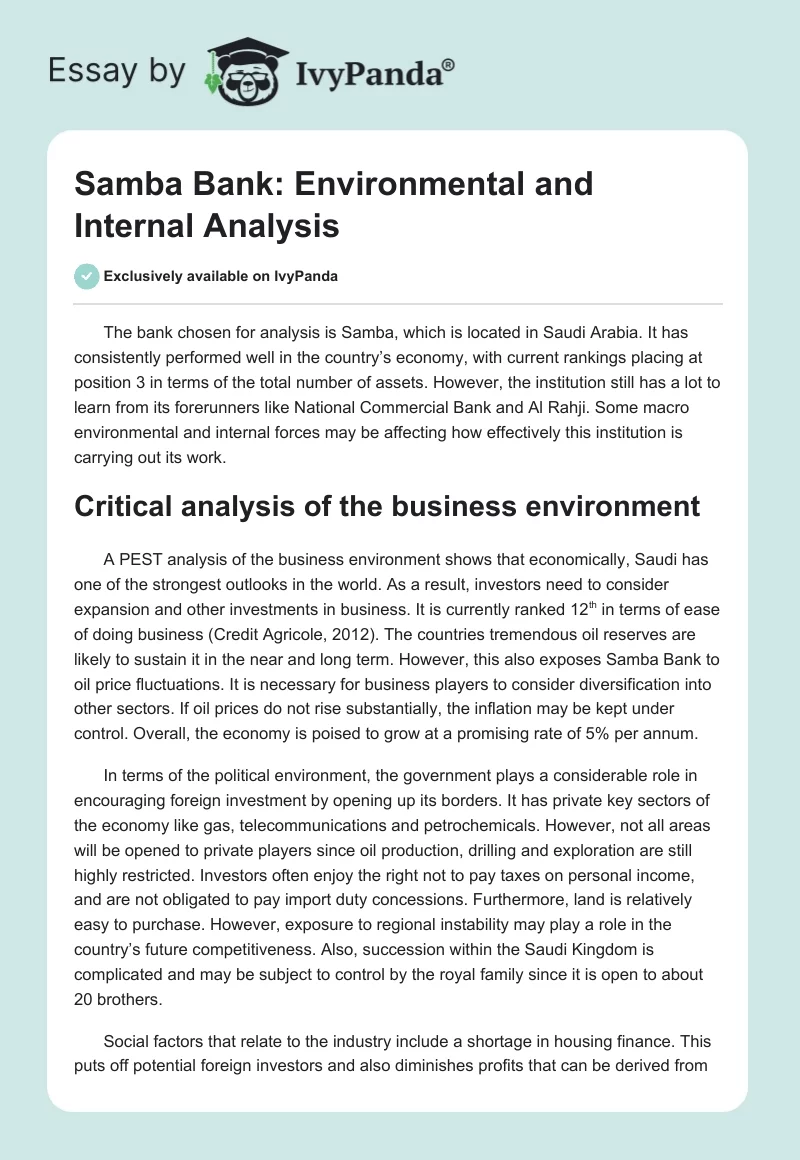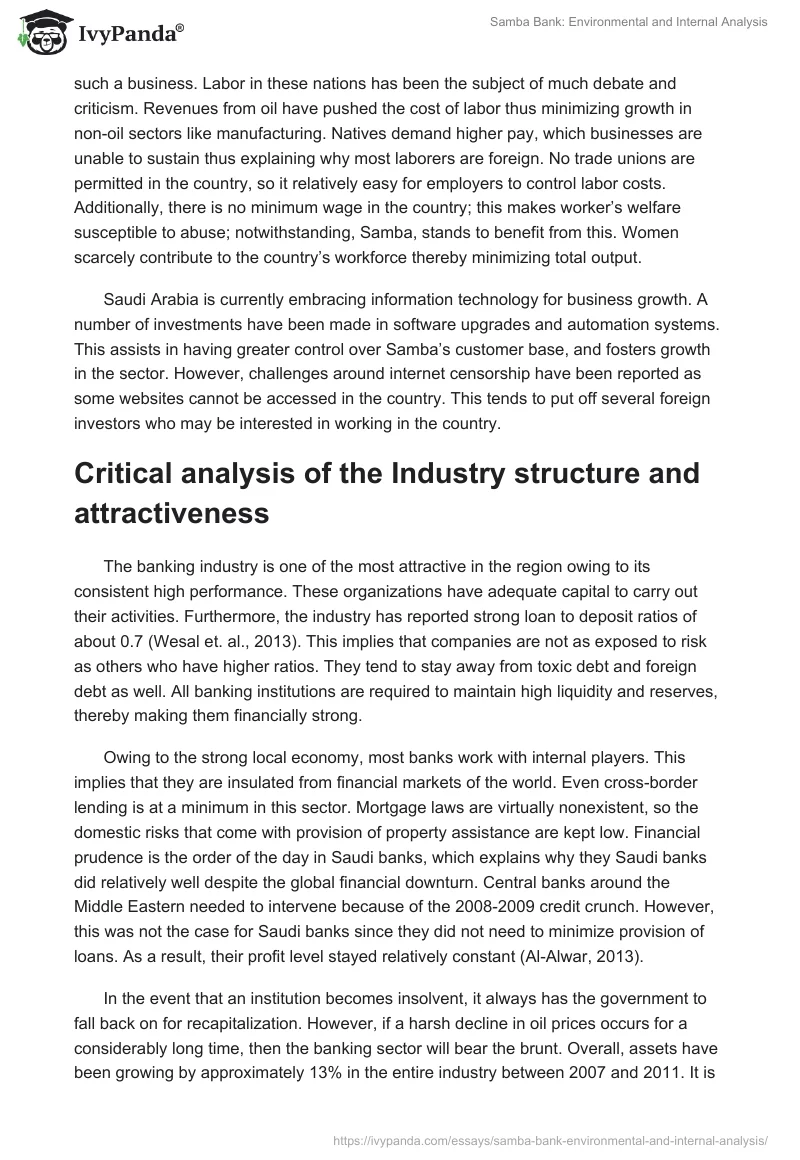The bank chosen for analysis is Samba, which is located in Saudi Arabia. It has consistently performed well in the country’s economy, with current rankings placing at position 3 in terms of the total number of assets. However, the institution still has a lot to learn from its forerunners like National Commercial Bank and Al Rahji. Some macro environmental and internal forces may be affecting how effectively this institution is carrying out its work.
Critical analysis of the business environment
A PEST analysis of the business environment shows that economically, Saudi has one of the strongest outlooks in the world. As a result, investors need to consider expansion and other investments in business. It is currently ranked 12th in terms of ease of doing business (Credit Agricole, 2012). The countries tremendous oil reserves are likely to sustain it in the near and long term. However, this also exposes Samba Bank to oil price fluctuations. It is necessary for business players to consider diversification into other sectors. If oil prices do not rise substantially, the inflation may be kept under control. Overall, the economy is poised to grow at a promising rate of 5% per annum.
In terms of the political environment, the government plays a considerable role in encouraging foreign investment by opening up its borders. It has private key sectors of the economy like gas, telecommunications and petrochemicals. However, not all areas will be opened to private players since oil production, drilling and exploration are still highly restricted. Investors often enjoy the right not to pay taxes on personal income, and are not obligated to pay import duty concessions. Furthermore, land is relatively easy to purchase. However, exposure to regional instability may play a role in the country’s future competitiveness. Also, succession within the Saudi Kingdom is complicated and may be subject to control by the royal family since it is open to about 20 brothers.
Social factors that relate to the industry include a shortage in housing finance. This puts off potential foreign investors and also diminishes profits that can be derived from such a business. Labor in these nations has been the subject of much debate and criticism. Revenues from oil have pushed the cost of labor thus minimizing growth in non-oil sectors like manufacturing. Natives demand higher pay, which businesses are unable to sustain thus explaining why most laborers are foreign. No trade unions are permitted in the country, so it relatively easy for employers to control labor costs. Additionally, there is no minimum wage in the country; this makes worker’s welfare susceptible to abuse; notwithstanding, Samba, stands to benefit from this. Women scarcely contribute to the country’s workforce thereby minimizing total output.
Saudi Arabia is currently embracing information technology for business growth. A number of investments have been made in software upgrades and automation systems. This assists in having greater control over Samba’s customer base, and fosters growth in the sector. However, challenges around internet censorship have been reported as some websites cannot be accessed in the country. This tends to put off several foreign investors who may be interested in working in the country.
Critical analysis of the Industry structure and attractiveness
The banking industry is one of the most attractive in the region owing to its consistent high performance. These organizations have adequate capital to carry out their activities. Furthermore, the industry has reported strong loan to deposit ratios of about 0.7 (Wesal et. al., 2013). This implies that companies are not as exposed to risk as others who have higher ratios. They tend to stay away from toxic debt and foreign debt as well. All banking institutions are required to maintain high liquidity and reserves, thereby making them financially strong.
Owing to the strong local economy, most banks work with internal players. This implies that they are insulated from financial markets of the world. Even cross-border lending is at a minimum in this sector. Mortgage laws are virtually nonexistent, so the domestic risks that come with provision of property assistance are kept low. Financial prudence is the order of the day in Saudi banks, which explains why they Saudi banks did relatively well despite the global financial downturn. Central banks around the Middle Eastern needed to intervene because of the 2008-2009 credit crunch. However, this was not the case for Saudi banks since they did not need to minimize provision of loans. As a result, their profit level stayed relatively constant (Al-Alwar, 2013).
In the event that an institution becomes insolvent, it always has the government to fall back on for recapitalization. However, if a harsh decline in oil prices occurs for a considerably long time, then the banking sector will bear the brunt. Overall, assets have been growing by approximately 13% in the entire industry between 2007 and 2011. It is postulated that these growth levels will continue to be sustained in the near future. Overall, the industry is attractive as it enjoys a rating of 2, which is only two countries away from being the safest banking system in the world.
Application of porter’s five forces
The degree of competition in the banking sector is relatively low as there are currently 20 active institutions in the industry. Among these, 12 of the banks control most of the assets with the remaining 8 accessing only 2%. The three largest institutions, including Samba, account for 45% of market share. This implies that the company is at a strong position monetarily.
Threats of new substitutes come in the form of specialized credit institution. The government has created these entities in order to account for gaps in loan provisions. Furthermore, the organizations do not work under capital market authority supervision like Samba. Currently, five of them operate in the Saudi economy, yet they account for 24% of loans lent to the private sector. Therefore, Samba is under considerable threat by these entities and should consider revising its loan portfolios.
Buyer power is relatively minimal in the country because of the ratio of banks to people. Consumers have minimal options from which to chose, so they have to contend with whatever the banks offer them. Additionally, they do not have the freedom to access home loans or other types of loans designed for their businesses. Banks in Saudi are extremely cautious thus putting buyers at a disadvantage in terms of what they can or cannot get from the enterprise. Many institutions have not yet reached the domestic deposit limit of 85% with most of them operating at 82%. Samba has an even lower ratio of 63% (Alawi, 2013).
New entrants have a relatively minimal risk of entry in the institution. Since organizations like Samba control a large share of the banking market, it is difficult for new entrants to complete with these huge institutions. It takes a long time before a bank establishes itself in the market and builds a brand that consumers can recognise. The huge capital investments needed to form a bank of considerable repute are prohibitive. This explains why the banking sector in Saudi is one of the most underpenetrated in the region. The Kingdom only has 46% while the UAE has 89% penetration and Qatar 69%. Furthermore, the country’s laws are rather strict for formation of new financial institutions. As a result, Samba is at a considerable advantage when it comes to this.
Finally, supplier power is relatively moderate in the industry. Only one institution is not listed (The National Commercial Bank), so the rest of them are exposed to the market directly and cannot attribute their success to the central bank or any national entity. Information technology providers who manage banks’ databases and information are high in number, so financiers have several options from which to choose. Those entities that control the ATM banking system, mobile and internet banking tend to belong to large conglomerates. Therefore, in this regard, banks appear to have diminished prospects.
Application of game theory in Samba and why this would be beneficial
Game theory requires stakeholders to consider the pros and cons of cooperation or individualistic behavior (Aumann, 2008). SME lending is at an all-time low in the Saudi banking sector. This category only accounts for 2% of the loans sector. If Samba decides to act alone, it may be taking on unusually high risk. Conversely, if the company cooperates with other institutions, then it may minimize its returns but be less insulated from shocks. The Saudi government has an industrial development fund designed to offer guarantees to bank lending to SMEs. However, those guarantees are likely to reduce if they are spread across a wide scope of players.
Using game theory, Samba can enjoy greater returns if it started this move towards greater SME lending. Furthermore, since the government offer guarantees, then it will be at a more advantageous position than those who begin late. It is for this reason that the company could gain from selfish behavior in SME financing.
Recommendations that would improve competitiveness
Samba needs to consider increasing its lending activity. In an effort to protect itself from toxic shock, the institution has refrained from taking advantage of this opportunity. Currently, the lowest loan-to-deposit ratios belong to Samba. It thus has a lot of room to expand lending risks without exposing itself to risks and violations of the country’s regulatory body. The bank has had considerable challenges with corporate lending, so it may want to consider SME lending as well as retail lending.
Under penetration may be dealt with by opening new branches in different parts of the country. Therefore, the organization needs to consider expanding in key commercial centers. A lot of profit can be made if the bank commits itself to this strategy. Since loans account for 37% of the penetration levels and deposits account for 46% of these activities, it makes more sense for the institution to focus more on lending rather than deposits when it stretches itself.
Finally, the company needs to consider entering the SME industry as explained in the earlier portion of the sector. The risks that put the company away can be mitigated through government support. Furthermore, SME sector contributions are substantially low in the Kingdom of Saudi Arabia compared to other parts of the region.
References
Alawi, A, 2013, Saudi banking sector. Web.
Al-Alwar, I, 2013, Saudi banking sector rock solid despite global economic crisis. Web.
Aumann, R, 2008, Game theory-The new palgrave dictionary of economics, McMillan, London. Web.
Credit Agricole, 2012, The kingdom of Saudi Arabia: An overview. Web.
Wesal, E., Hanan, A, Gomaa, M, Afafa, A, Taiha, B, 2013, Saudi banking sector – current and future trends. Web.


